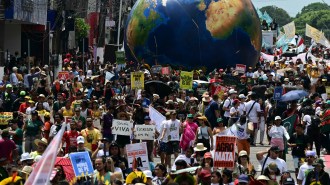Students worldwide are striking to demand action on climate change
More than 1,000 events are planned March 15 to protest government failure to cut emissions
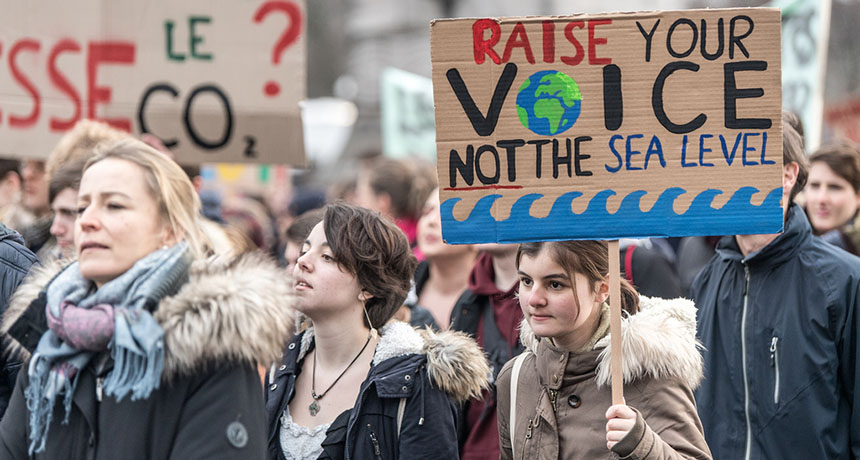
TAKING ACTION These students in Lausanne, Switzerland, marching on February 2, are among thousands who have protested in the last few months over governments’ failure to take stronger action to deal with climate change. A global strike is planned for March 15.
GUSTAVE DEGHILAGE/FLICKR (CC BY-NC-ND 2.0 )
For the past several months, growing numbers of students around the world have been cutting class — not to play but to protest.
The topic driving them is the same: Earth’s changing climate, as evidenced by increasing wildfires and droughts, rising seas and more extreme weather. As the students see it, governments have not done enough to cut the emissions of greenhouse gases, such as carbon dioxide, to limit global warming or to plan ways to adapt to the impacts of climate change.
On March 15, this student-led protest will crescendo with a coordinated strike set to take place across the globe. More than 1,300 events are planned in 98 countries from Argentina to Vanuatu, according to a list kept by the group Fridays For Future.
“These kids speak with a moral clarity and poignancy that none but the most jaded of ears can fail to hear,” says Michael Mann, a climate scientist at Penn State. He says he believes the school-strike movement “is part of why we will soon see a tipping point on climate action here in the U.S. and around the rest of the world.”
What motivates Milou Albrecht, 14, of Castlemaine, Australia, who is a coleader of strikes in her country, is worry about wildfires. When she was little, a fire quickly approached the bush country where she was playing at a friend’s house. Smoke filled the air, she recalls, and everyone had to evacuate. “You didn’t know what to take, so we didn’t take anything.”

The planet’s average temperature has risen about 1 degree Celsius since preindustrial times, according to a 2018 report by the United Nations’ Intergovernmental Panel on Climate Change, or IPCC (SN: 12/22/18, p. 18). Human-induced global warming already has caused multiple changes in Earth’s climate, the IPCC noted in its report, pointing to more heat waves, more and heavier rains or snow events and a greater risk of drought.
If emissions continue at the current rate, the increase in average global temperatures will hit 1.5 degrees C sometime between 2030 and 2052, the IPCC says. Beyond that point, impacts will be even more severe.
And the longer people wait to cut back releases of greenhouse gases, the more difficult it may be. For instance, the longer U.S. auto and energy companies wait, the higher the costs for any action would be, according to an October 2017 study in Environmental Science & Technology.
Such data, many students now argue, means the time to act is now.
A worldwide movement
Many young protesters have drawn inspiration from Greta Thunberg, a 16-year old Swedish teen with Asperger’s syndrome. Although this mild form of autism can leave people uncomfortable in social situations, Greta began regularly protesting outside Sweden’s Parliament during the summer of 2018. Her protests inspired the Fridays for Future movement.
Greta also has encouraged kids to strike in other countries and spoke to delegates at the 2018 United Nations Climate Change Conference (UNCCC), held in December in Katowice, Poland.
“You say you love your children above all else, and yet you are stealing their future in front of their very eyes,” Greta testified. There is still time to limit the worst impacts, she noted — but only if governments act now. “Until you start focusing on what needs to be done rather than what is politically possible,” she said, “there is no hope.”
Greta’s message has spread like wildfire. Twelve-year-old Haven Coleman from Denver, a coleader of the U.S. school strikes, was inspired to act by changes she’s seen in her part of the world. “We’re affected by floods and fires, and we’ve been in a 19-year drought,” she says. Climate change will make such events more common and worsen air pollution, especially from wildfires. And that makes it even more personal for Haven: She has asthma, so breathing dirty air already causes her problems.
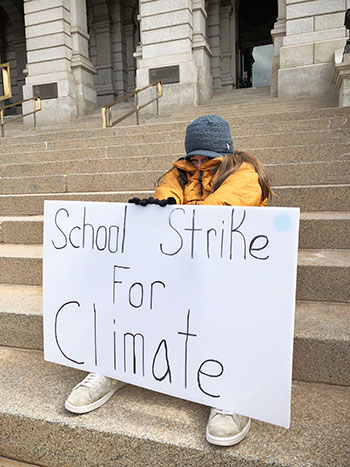
“All ages are welcome for the climate strikes,” says the 22-year-old. “Not being a teen does not stop you from striking for climate.”
The impacts of Earth’s changing climate will hit developing countries, like hers, especially hard. Many people there have limited electricity, few government services and low incomes. And residents are more likely to work outside, where they’re subject to extreme heat or other problems. These people also tend to have less money to pay for steps to adapt, such as buying and running an air conditioner.
“Climate denialism is like suicide,” Nakate says of the people who argue climate change is not happening. “We cannot let ourselves perish as we look on without doing anything,” she says. “Not taking climate action is like locking yourself up in a house on fire.”
Demanding change
If adults are the ones who need to act, why are kids protesting? “It is our generation which has the highest stake in this,” explains 15-year-old Scarlet Possnett, a Suffolk, England, teen who is an organizer of YouthStrike4Climate. A big first step is for governments to recognize climate change as a crisis, she says. And many, seemingly, do not see the urgency, she adds.
Just 100 companies across the globe are responsible for 70 percent of the greenhouse gases driving climate change, Possnett notes, citing figures from a 2017 report from CDP, a British group that gathers data on pollution. Those big companies won’t reduce emissions on their own, the teen believes. To prompt them to act, she argues, “there needs to be a policy change.”
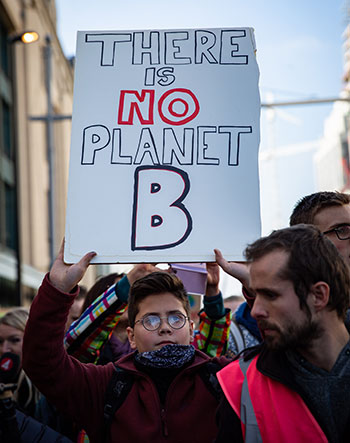
But, the study points out, these cuts so far “fall a long way short” of achieving the goals of the 2015 Paris Agreement, in which most of the world’s nations have pledged to limit global warming to 2 degrees Celsius above preindustrial levels. Doing that will require cutting emissions by roughly 25 percent over the next 10 years, Corinne Le Quéré at the University of East Anglia in England and her colleagues reported in Nature Climate Change February 25, 2019. Key to that will be huge moves “to phase out the use of fossil fuels,” the report says.
Dealing with dread
Many young people can hardly remember a time when Earth’s changing climate did not threaten them, says Lilah Williamson. And going forward, “we’re not going to know a time without [its] impending doom,” says this 14-year old from Burnaby, Canada. The region where she lives has suffered from storms that have been dumping heavier rains than in the past. There also have been more droughts and wildfires. “I just can’t imagine what it’s going to be like in the future,” she says.
Such students can feel burdened by a type of dread, points out Susie Burke, a psychologist in Castlemaine, Australia, and Milou’s mom. Imagining how climate change will affect them leaves many kids anxious, as well as empathetic toward others suffering from these severe events, she and her colleagues reported May 2018 in Current Psychiatry Reports in a study about the psychological impacts of climate change.
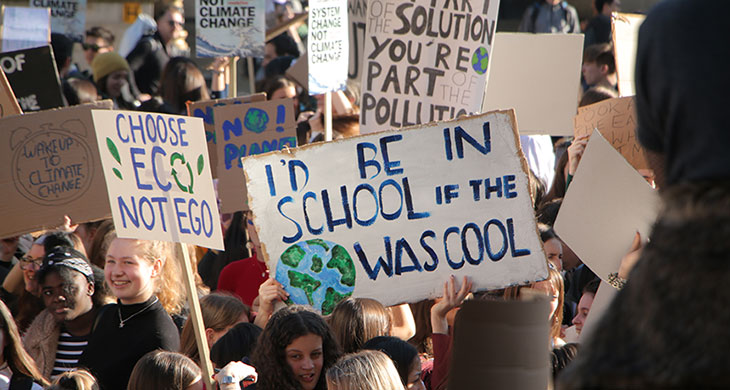
Burke supports her daughter’s protests. School strikes are a “problem-focused” way of coping with climate’s impacts, she says.. “You try to do something about the problem that is causing you stress.” The protests can reassure children and teens that they’re not alone: “Your concerns are shared by a whole bunch of people.”
Learning about climate change and its impacts can seem overwhelming, says Milou. But taking part in climate protests has “felt empowering,” inspiring and even fun.
And, if the global strike is any indication, getting governments to act on climate change is crucial to the next generation. As Greta told the United Nations meeting, “We have run out of excuses, and we are running out of time.”


